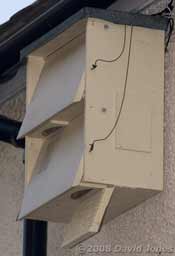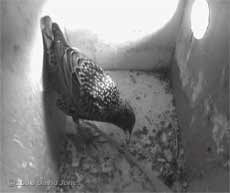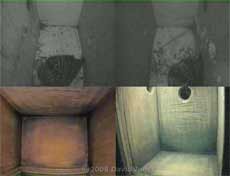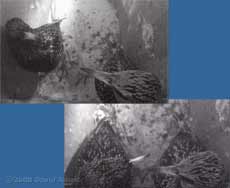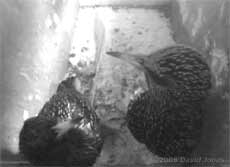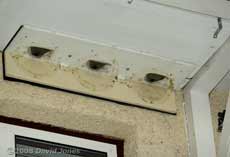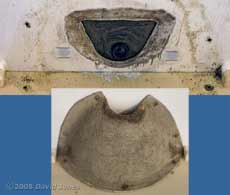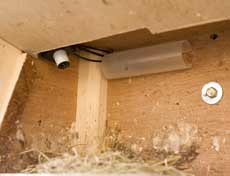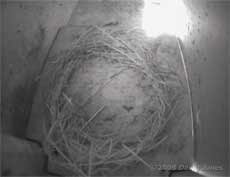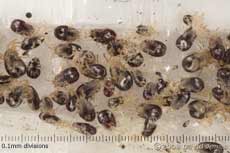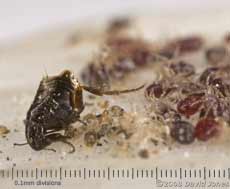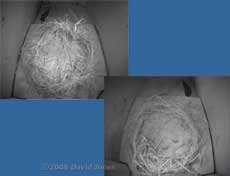Go to the last entry on this page Go to previous entry11 February - The Starling followed the same pattern of behaviour again today, with the female becoming active first, at around 6am, with the male not starting to move about until after 6.30am. They were both by the entrances by 7am and they left together a few minutes later. There was a short period of activity after 8am when both birds appeared in the boxes and a bit of floor cleaning done, and then there was a long gap before the male visited at around mid-day. The end of day routine started with the female arriving around 4.30pm and the male around 4.50pm. Once again, both birds visited the other's box before they settled down for the night with the female in box R and her partner in box L. There were no visits at all to the Tit box today. Tonight, I made arrangements to add a second camera to that box, this time inside the box itself to look straight down onto the nest. I need to seal the camera casing today so it won't actually be in place until a few days time.
12 February - The misty start to the day seemed to make a difference to the Starlings, As usual, the female was active first, from 6am, with the male moving about from 6.15am. Both were at the entrances by 7am, but this morning they didn't leave until 7.25am, with the female leaving first. After that there were none of the usual visits between 8 and 9am, and although I saw them in the garden during the day they didn't approach the boxes again until the female arrived there at 4.50pm. Both birds entered both boxes over the next five minutes before ending up in the usual males in box L, female in box R arrangement. However, after a pause of five minutes the female decided to visit her partner, staying for the best part of fifteen minutes. For much of the time the tension between the pair was high, with the male especially nervous of any sudden move made by his partner (such as when she dealt with an itch!). It one time she seemed to start to move sideways towards him, to be greeted by a quick stab from his beak. She retaliated briefly but the incident was soon over and she turned her back on him. He moved behind her and I think attempted to mate with her. It was over very quickly and followed by another exchange of beak thrusts. For the best part of ten minutes the two stood near each other but with no more attacks from either partner. Finally, at 5.20pm the female headed back to box R. There have been no visits to the Tit box today. I have sealed the camera that I will install in there, and I may get that job done tomorrow night.
I've also sealed the cameras in the Swift boxes, and added a new grooved 'ramp' to the entrance of the lower box. The lengths of string that you can see are attached to steel pins that I use to secure the doors in the up position when I want to access the boxes. My next major nestbox task is to check out the House Martin cameras and refit the actual nests (which are sitting in a shed at the moment).
After that they didn't return until 5pm when the female entered box R, closely followed by her partner. There was no sign of courtship or aggression and the male soon left her to return to box L to end their activities for the day.
The Great Tit didn't enter the Tit box today, but it did appear at the entrance twice, at 9.50am and then 3pm, and I heard the male calling for near the box at several other times while I worked outside. As of tonight there are now two cameras dedicated to the Tit box, and this is the composite image that have on my monitor as I write this.
The difference in colour rendition is quite striking between the two cameras. The new camera is balanced for daylight use and at the moment the box is being illuminated by white LED's in addition to a tungsten light bulb. I'll be interested in comparing the images during daylight.
14 February - No visits at all today to the Tit box , although the Great Tit pair were here frequently to feed. The Starlings' day was much as usual, although this evening the female didn't appear until nearly 5pm. When the male arrived he also entered box R and spent several minutes in there before heading into box L. During his stay there was no attempt at mating, but his behaviour was interesting. The female had already tucked herself into the right hand corner before he arrived. On entering the box he settled in next to her (lower image), giving a excellent chance to compare their different head plumage patterns. Several times I saw him start to turn his head away, only to turn back quickly and peck at his partner in what appeared to be an unprovoked attack (or was it courtship??). Each time, she would peck back at him, but the encounter didn't escalate. There would then be a pause before it happened again. Eventually he turned, headed for the entrance, and left, entering box L immediately. Both birds then settled down for the night. I haven't done anything with the Tit box cameras since last night, but I may chance the lens on the 'new' camera to give a narrower field of view on the area where I would expect any nest to be built, rather than the present wide view of the box. Also, I may try using a different camera for the side view, a camera that allows me to change its rendition of colour according to the main light source.
16 February - On a very cold, bright morning the Starlings were both awake and moving about by 6.25am and had left their boxes by 7.05am. Between then and 10am there were eight visits by the female and two by the male. Then the boxes stayed empty until the female returned to box R at 4.50am. Over the next five minutes she made several visits to box L before settling back in box R.
During the visit there were no aggressive moments, the female hardly moving the whole time the male was in the box with her.
I spent a couple of hours up in my loft (and also up a ladder) today making all the connections to the remaining nestbox cameras and all the microphones, so I was able to record the male's serenade and you can hear it by clicking here. The recording (about 31 seconds long with a file size of 485 Kilobytes) is complete, with no cropping, but just a touch of high-pass filter used to take away some of the backround rumble that always affects recordings made here. The end of his song came suddenly, and he turned and left immediately afterwards. It's interesting to compare this song with the longer, but noisier recording from last year that is already in the sounds section of the website. The cameras and microphones in both the Swift and House Martin nestboxes are now connected, although the Martin nests themselves are not in place yet as I hope to install infrared LEDs in all three sometime in the next week. I also need to add diffusers to the IR LEDs in the Swift boxes to reduce the lighting 'hotspot' that exists at the moment. Once those jobs are done, all these cameras will be switched off until the Swifts and martins appear overhead late April/May. The Tit box remained unvisited today.
18 February - Another 'no-show' day in the Tit box, but a slight change of routine in the Starling household. Both birds were active by 6.15am, although the male got going first today, and they were both out of their boxes by 6.58am. Between 7.25-9.30am they both visited the boxes quite a lot, although they were never in a the same box at the same time. After 9.30am they didn't visit again until the male entered box L at 5.11pm. His partner didn't arrive until five minutes later, and as soon as she entered box R the male (still in box L - there is just a thin partition between boxes) launched into another, longer song sequence. The recording starts with the noise of the female entering box R and is completely unedited. It lasts 39 seconds and has a file size of 619KB. You can hear the recording by clicking here. As before, the song finished abruptly, and this time both birds simply preened a bit and settled down for the night. I installed the IR LEDs in the House Martin nestbox framework today, using diffusers made from the sides of a yoghurt pot, and that is now ready to be put up, perhaps tomorrow.
The nests themselves will be fitted on another day - that will take a while to do as I need to check the camera angles at the same time.
The upper picture shows one of the nest locations, with the camera lens protruding through a rubber 'anti-bug' barrier. Either side of it you can see the circular diffusers, behind which are the IR LEDs, set in holes drilled at angles through the timber so that the IR light is directed towards the central area of the nest.
I've also fitted diffusers to the IR LEDs in the Swift boxes. There are two LEDs in each box, and these are now behind diffusers made from toothpaste tubes.
This is the image produced by the camera in that (lower) box, with the IR LEDs illuminating the area inside the ring of straw. It looks as though I may need to adjust their positions slightly, but I shall check the image after dark to confirm this.
Yet again, there were no visits to the Tit box today, despite the Great Tits spending a lot of time in the garden. There seems to be a bit of a problem with the camera in the Starlings' right hand box tonight. During the day the image has become rather cloudy for some reason. I have noticed a lot of insect activity appearing as blurred silhouettes crossing the lens over the last week and I'm keeping my fingers crossed that they haven't managed to enter the camera, as happened last year. I shall have to check it out tomorrow. The Starling themselves have followed their 'usual' daily pattern with a few variations. Both were active by 6.05am and out of the boxes at 7.06am. The box cleaning session went from around 7.40am to about 9am, and on one occasion they met up in box L. The male was already in there when the female entered. She immediately made a couple of sharp calls and he dodged past her and left! This very short recording covers that sequence - listen here. Tonight the female returned to box R at around 5pm. A minute later and she went into box L, inspected it and returned to box R. Her partner appeared at 5.07pm, joining her in box R. There was a very brief attempt at a song, but the female was clearly not interested and he headed for box R. At 5.40pm, he headed into box R again. Clearly, he was not welcome, judging by the pecks he received, and he quickly returned to box L, both birds then settling down for the night.
20 February - After yesterday's observations, I had the ladder out this morning, starting with the Starling box. A dirty lens was quickly ruled out as the cause of the cloudy image from the box R camera, and as soon as I removed the lens the real culprits were revealed, a large number of tiny mites (or are they ticks?) inside the camera. I had, so I thought, carefully cleaned the camera before sealing it a couple of weeks ago, but either I missed some eggs, or the seal wasn't as complete as I had thought. I removed the camera (so no visual monitoring of that box today, although there is still a microphone in use) and dismantled it before leaving it to soak for several hours in Methylated Spirits, brushing all surfaces a couple of times to try and remove any eggs that were present, and changing the meths for a final soak. Eventually I took the camera out to dry it so that I could re-assemble and test it this evening before resealing it. So that I could photograph the creatures I poured the meths through a sieve lined with kitchen paper which I allowed to dry before tipping the contents into a petri dish. To my surprise, the mites/ticks very soon started to move about again! I decided not to waste time and dumped the petri dish into a strong bleach solution. Does this mean that any eggs still in the camera will also have survived? Just in case, when I re-assemble the camera I'm going to add a rubber foam barrier around the sensor. This will press against the front of the camera casing and seal off the sensor/lens space from the rest of the camera. Once the nesting season is over I will check the camera again and, if necessary, work on a different strategy for next year. As the camera in nest L was also used last year, I may try to pre-empt this problem by inserting a foam barrier in that as well, before we get much closer to nesting. In the way of a hint about the approach of that time, while I was up the ladder I watched a Magpie visit my neighbour's Birch tree and take away a twig. I usually see this happening during March so it looks as though the Magpies are starting early this year. Behind the Starling box I had attached some wide adhesive tape, partly as a shelter for some of the wiring connections, but also as a 'bug trap'. As I disconnected the camera, I needed to remove that tape, giving be an opportunity to photograph some of the trapped beasts - while well and truly stuck, most of them were still very much alive!
There were hundreds of the tiny creatures which I think resemble ticks rather than mites,
and a single flea!
As a precaution, the clothes that I wore were washed immediately after I finished! Tomorrow I will probably go out and get some disposable overalls before working on the boxes again.
I thought that I may have moved it a bit too far, but the image doesn't look too bad tonight, and I'll probably not touch these boxes again until the nesting season is over. Click on the images to see larger versions - |
|
